Related Research Articles

Euxenite, or euxenite-(Y), is a brownish black mineral with a metallic luster.

The mineral group tantalite [(Fe, Mn)Ta2O6] is the primary source of the chemical element tantalum, a corrosion (heat and acid) resistant metal. It is chemically similar to columbite, and the two are often grouped together as a semi-singular mineral called coltan or "columbite-tantalite" in many mineral guides. However, tantalite has a much greater specific gravity than columbite (8.0+ compared to columbite's 5.2). Iron-rich tantalite is the mineral tantalite-(Fe) or ferrotantalite and manganese-rich is tantalite-(Mn) or manganotantalite.
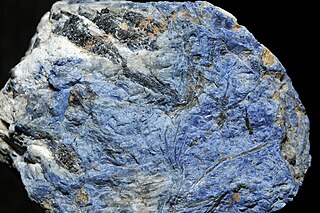
Dumortierite is a fibrous variably colored aluminium boro-silicate mineral, Al7BO3(SiO4)3O3. Dumortierite crystallizes in the orthorhombic system typically forming fibrous aggregates of slender prismatic crystals. The crystals are vitreous and vary in color from brown, blue, and green to more rare violet and pink. Substitution of iron and other tri-valent elements for aluminium result in the color variations. It has a Mohs hardness of 7 and a specific gravity of 3.3 to 3.4. Crystals show pleochroism from red to blue to violet. Dumortierite quartz is blue colored quartz containing abundant dumortierite inclusions.
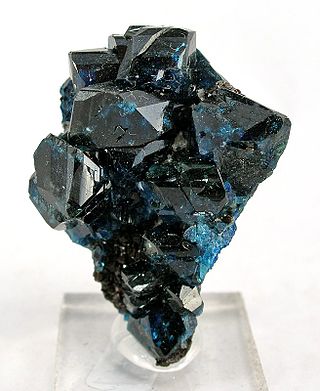
Lazulite ((Mg,Fe2+)Al2(PO4)2(OH)2) is a blue, phosphate mineral containing magnesium, iron, and aluminium phosphate. Lazulite forms one endmember of a solid solution series with the darker iron rich scorzalite.
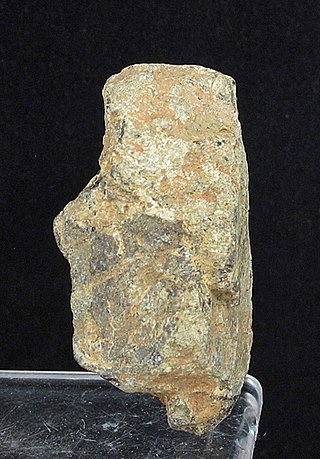
Polycrase or polycrase-(Y) is a black or brown metallic complex uranium yttrium oxide mineral with the chemical formula (Y,Ca,Ce,U,Th)(Ti,Nb,Ta)2O6. It is amorphous. It has a Mohs hardness of 5 to 6 and a specific gravity of 5. It is radioactive due to its uranium content. It occurs in granitic pegmatites.

Zimbabweite is a mineral; formula (Na,K)2PbAs4(Nb,Ta,Ti)4O18. It is generally classed as an arsenite but is notable for also containing niobium and tantalum. A yellow brown mineral with orthorhombic crystal habit and a hardness of 5. It was discovered in 1986 in kaolinized pegmatite, i.e. weathered to clay, in Zimbabwe.
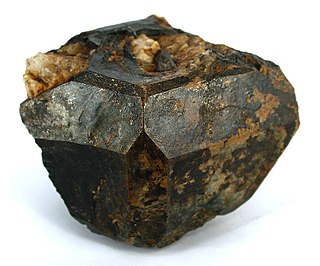
Microlite was once known as a pale-yellow, reddish-brown, or black isometric mineral composed of sodium calcium tantalum oxide with a small amount of fluorine. Its chemical formula is(Na,Ca)2Ta2O6(O,OH,F). Today it is a name of a group of oxide minerals of a similar stoichiometry having tantalum prevailing over titanium and niobium. The microlite group belongs to a large pyrochlore supergroup that occurs in pegmatites and constitutes an ore of tantalum. It has a Mohs hardness of 5.5 and a variable specific gravity of 4.2 to 6.4. It occurs as disseminated microscopic subtranslucent to opaque octahedral crystals with a refractive index of 2.0 to 2.2. Microlite is also called djalmaite, but both names are now obsolete.

Betafite is a mineral group in the pyrochlore supergroup, with the chemical formula (Ca,U)2(Ti,Nb,Ta)2O6(OH). Betafite typically occurs as a primary mineral in granite pegmatites, rarely in carbonatites. Originally defined by the B-site atom Ti, the development of new nomenclature for mineral names led to modernization of the system for nomenclature of pyrochlore and betafite in order to further rationalize the naming process of this grouping of minerals. Only two of the mineral species that were formerly recognized as betafite are presently retained. They are oxyuranobetafite and oxycalciobetafite. The term betafite is now a synonym or varietal group name under the pyrochlore super group.

Tapiolite [(Fe, Mn)(Nb, Ta)2O6] is a black mineral series that is an ore of niobium and tantalum. The tapiolite group includes tapiolite-(Fe) or ferrotapiolite and tapiolite-(Mn) or manganotapiolite. Tapiolite-(Fe) is by far the more common of the two.

Ixiolite is an accessory oxide mineral found in granitic pegmatites. It is an oxide with the general chemical formula (Ta,Nb,Sn,Mn,Fe)4O8 or (Ta,Mn,Nb)O2.
Billwiseite is a very rare oxide mineral found at the pegmatite commonly referred to as "Stak Nala" located within a few hundred yards from the village of Toghla in the Stak Nala, Gilgit-Baltistan Pakistan. It has only been found as a coating on a single crystal of lepidolite. The sole rock containing Billwiseite is kept at the Royal Ontario Museum, catalogue number M5595.

Kentbrooksite is a moderately rare mineral of the eudialyte group, with chemical formula (Na,REE)15(Ca,REE)6Mn3Zr3NbSi[(Si9O27)2(Si3O9)2O2]F2·2H2O. This extended formula shows the presence of cyclic silicate groups and dominance of Si at the M4 site, according to the nomenclature of the eudialyte group. The characteristic features of kentbrooksite, that make it different from eudialyte are: (1) dominancy of fluorine (the only currently known example among the whole group), (2) dominancy of manganese, and (3) dominancy of niobium. Trace hafnium and magnesium are also reported. Kentbrooksite is relatively common when compared to most other species of the group.

Schiavinatoite is a very rare mineral, a natural niobium borate with the chemical formula (Nb,Ta)BO4. Schiavinatoite is classified as monoborate. It contains tetrahedral borate anion instead of planar BO3 group, which is more common among minerals. Schiavinatoite is one of the most simple niobium minerals. It forms a solid solution with its tantalum-analogue, béhierite. Both minerals possess zircon-type structure (tetragonal, space group I41/amd) and occur in pegmatites. Schiavinatoite and nioboholtite are minerals with essential niobium and boron.

Béhierite is a very rare mineral, a natural tantalum borate of the formula (Ta,Nb)BO4. Béhierite is also one of the most simple tantalum minerals. It contains simple tetrahedral borate anions, instead of more common among minerals, planar BO3 groups. It forms a solid solution with its niobium-analogue, schiavinatoite. Both have zircon-type structure (tetragonal, space group I41/amd) and are found in pegmatites. Béhierite and holtite are minerals with essential tantalum and boron.
Szklaryite is an extremely rare mineral with the formula []Al6BAs33+O15. It is essentially vacant ("[]"), arsenic-dominant member of dumortierite supergroup, giving a name of szklaryite group. It is one of three quite recently found minerals of this group, the other two being nioboholtite and titanoholtite, all coming from the Szklary village near Ząbkowice Śląskie in Poland. They occur in a unique pegmatite of probable anatectic origin.
Titanoholtite is an extremely rare mineral with the formula (Ti0.75[]0.25)Al6BSi3O18. It is titanium-rich member of dumortierite supergroup, and titanium-analogue of holtite of the holtite group. It is one of three quite recently found minerals of this group, the other two being nioboholtite and szklaryite, all coming from the Szklary village near Ząbkowice Śląskie in Poland. They occur in a unique pegmatite of probable anatectic origin.
Peterandresenite is a very rare mineral, the first known natural hexaniobate. Its chemical formula is Mn4Nb6O19•14H2O. Its structure contains a special type of octahedron: Lindqvist ion. Peterandresenite was found in a pegmatite of the Larvik complex in Norway. It is somewhat similar to other unique niobium minerals, aspedamite and menezesite.
Charleshatchettite is a very rare, complex, niobium oxide mineral with the formula CaNb4O10(OH)2•8H2O. It was discovered in the mineral-rich site Mont Saint-Hilaire, Montérégie, Québec, Canada.
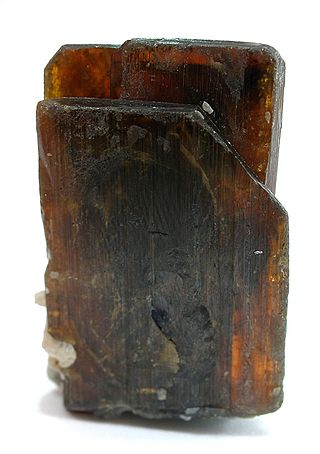
Stibiotantalite is a mineral consisting of Sb(Ta,Nb)O4. It is found in complex granite pegmatites.
Vigezzite is a variant of the mineral aeschynite containing calcium, cerium, niobium, tantalum, and titanium. It was first discovered near Orcesco, Valle Vigezzo, Provo Novara, Northern Italy, in cavities of an albitic rock. The crystals of Vigezzite are flat prismatic crystals up to 2-3 mm length of an orange-yellow color.The name Vigezzite was chosen to draw attention to the locality that has produced the first occurrence of a Ca-Nb-Ta-mineral with Nb dominance over Ta, crystallizing with the aeschynite structure. The ideal chemical formula for vigezzite is (Ca,Ce),(Nb,Ta,Ti)2O6
References
- ↑ Warr, L.N. (2021). "IMA–CNMNC approved mineral symbols". Mineralogical Magazine. 85 (3): 291–320. Bibcode:2021MinM...85..291W. doi:10.1180/mgm.2021.43. S2CID 235729616.
- 1 2 3 4 Pieczka, A.; Evans, R. J.; Grew, E. S.; Groat, L. A.; Ma, C.; Rossman, G. R. (2013). "The dumortierite supergroup. II. Three new minerals from the Szklary pegmatite, SW Poland: Nioboholtite, (Nb0.6〈0.4)Al6BSi3O18, titanoholtite, (Ti0.75〈0.25)Al6BSi3O18, and szklaryite, 〈Al6BAs3+3O15". Mineralogical Magazine. 77 (6): 2841. Bibcode:2013MinM...77.2841P. doi:10.1180/minmag.2013.077.6.10. S2CID 51740732.
- ↑ "Nioboholtite: Nioboholtite mineral information and data". Mindat.org. Retrieved 2016-03-03.
- ↑ "Schiavinatoite: Schiavinatoite mineral information and data". Mindat.org. Retrieved 2016-03-10.